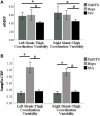An Analysis of Lower Limb Coordination Variability in Unilateral Tasks in Healthy Adults: A Possible Prognostic Tool
- PMID: 35782503
- PMCID: PMC9247147
- DOI: 10.3389/fbioe.2022.885329
An Analysis of Lower Limb Coordination Variability in Unilateral Tasks in Healthy Adults: A Possible Prognostic Tool
Abstract
Interlimb coordination variability analysis can shed light into the dynamics of higher order coordination and motor control. However, it is not clear how the interlimb coordination of people with no known injuries change in similar activities with increasing difficulty. This study aimed to ascertain if the interlimb coordination variability range and patterns of healthy participants change in different unilateral functional tasks with increasing complexity and whether leg dominance affects the interlimb coordination variability. In this cross-sectional study fourteen younger participants with no known injuries completed three repeated unilateral sit-to-stands (UniSTS), step-ups (SUs), and continuous-hops (Hops). Using four inertial sensors mounted on the lower legs and thighs, angular rotation of thighs and shanks were recorded. Using Hilbert transform, the phase angle of each segment and then the continuous relative phase (CRP) of the two segments were measured. The CRP is indicative of the interlimb coordination. Finally, the linear and the nonlinear shank-thigh coordination variability of each participant in each task was calculated. The results show that the linear shank-thigh coordination variability was significantly smaller in the SUs compared to both UniSTS and Hops in both legs. There were no significant differences found between the latter two tests in their linear coordination variability. However, Hops were found to have significantly larger nonlinear shank-thigh coordination variability compared to the SUs and the UniSTS. This can be due to larger vertical and horizontal forces required for the task and can reveal inadequate motor control during the movement. The combination of nonlinear and linear interlimb coordination variability can provide more insight into human movement as they measure different aspects of coordination variability. It was also seen that leg dominance does not affect the lower limb coordination variability in participants with no known injuries. The results should be tested in participants recovering from lower limb injuries.
Keywords: continuous hops; interlimb coordination; interlimb coordination variability; unilateral functional tasks; unilateral sit to stand.
Copyright © 2022 Ghahramani, Mason, Pearsall and Spratford.
Conflict of interest statement
The authors declare that the research was conducted in the absence of any commercial or financial relationships that could be construed as a potential conflict of interest.
Figures




Similar articles
-
Effects of running skill and speed on limb coordination during submaximal and maximal sprinting.J Biomech. 2024 Mar;166:112023. doi: 10.1016/j.jbiomech.2024.112023. Epub 2024 Feb 22. J Biomech. 2024. PMID: 38447429
-
Effects of knee sleeves on coordination of lower-limb segments in healthy adults during level walking and one-leg hopping.PeerJ. 2017 May 18;5:e3340. doi: 10.7717/peerj.3340. eCollection 2017. PeerJ. 2017. PMID: 28533981 Free PMC article.
-
Interlimb Force Coordination in Bipedal Dance Jumps: Comparison Between Experts and Novices.J Appl Biomech. 2018 Dec 1;34(6):462-468. doi: 10.1123/jab.2017-0216. J Appl Biomech. 2018. PMID: 29809067
-
Interlimb neural coupling: implications for poststroke hemiparesis.Ann Phys Rehabil Med. 2014 Dec;57(9-10):696-713. doi: 10.1016/j.rehab.2014.06.003. Epub 2014 Jun 27. Ann Phys Rehabil Med. 2014. PMID: 25262645 Review.
-
Interlimb Coordination During Step-to-Step Transition and Gait Performance.J Mot Behav. 2015;47(6):563-74. doi: 10.1080/00222895.2015.1023391. Epub 2015 Apr 20. J Mot Behav. 2015. PMID: 25893693 Review.
Cited by
-
The Measure of Motion Similarity for Robotics Application.Sensors (Basel). 2023 Feb 2;23(3):1643. doi: 10.3390/s23031643. Sensors (Basel). 2023. PMID: 36772683 Free PMC article.
-
Changes in Coordination and Its Variability with an Increase in Functional Performance of the Lower Extremities.Biosensors (Basel). 2023 Jan 19;13(2):156. doi: 10.3390/bios13020156. Biosensors (Basel). 2023. PMID: 36831922 Free PMC article.
References
-
- Albano D., Lambiase G., Romano B., Vastola R. (2021). Nonlinear Analysis of Knee Kinematic Variability after ACL Reconstruction for the Return to Sport. J. Phys. Educ. Sport 21 (2), 922–926. 10.7752/jpes.2021.02114 - DOI
-
- Bernstein N. A. (1967). The Coordination and Regulation of Movements. New York: Pergamon.
LinkOut - more resources
Full Text Sources
Research Materials
Miscellaneous

